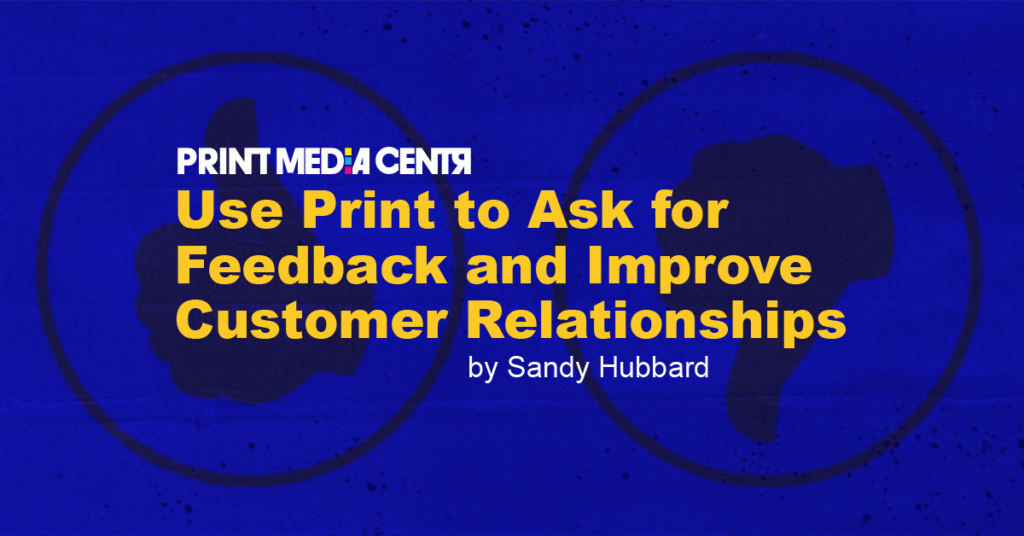
To improve our businesses, we need to continuously learn about the people we serve. Think about the process of asking for customer feedback, for example. While it’s not specifically a marketing activity, it shows customers we care about our relationship with them and we want to serve them better.
When you ask for customer feedback, print is a perfect way to do it!
Furthermore, by leading the way with print in this type of dialog, it shows customers how to use print in their own outreach.
IDEAS FOR PRINTED FEEDBACK FORMS
Surveys. Build surveys that help you identify trends and get a big-picture understanding of your customers. Phrase questions to understand their needs and where they are headed. You can send the survey in print and give recipients the chance to reply online. It’s nice for customers to be able to read the questions in print to lure them in and motivate them to reply. Remember, people will be most interested if the survey is about them, not you!
Customer feedback forms. Print forms to hand to customers, place in packages, slip into bags, or set on counters/tables. Even if customers get a form every time they visit your shop, they’ll know you care.
Complaint box. Create printed forms with category headers or prompts to guide people in giving constructive complaints. This will help you get situations resolved correctly.
Questionnaires. Use lists and checkboxes to ask for customer preferences. It’s helpful if you offer choices between options that are somewhat similar*. Compare apples to apples, and you’ll end up with specific data from your customers that you can use in making their experience more tailored.
Employee shout-outs. Print forms asking if the customer would like to compliment one of your employees for a job well done. I know for myself, I have a dental hygienist who is peachy. I love filling out the form, and sometimes I see my comments on my dentist’s bulletin board or in their newsletter.
Interactive forms and voting. Remember hanging chads from the Bush-Gore presidential election in 2000? The user punches out a perforated checkbox to signify their choice. Customers can vote on preferences and not have to pull out a pen to mark a ballot. Forms can also have QR codes, shortened links, or other touch-free ways to vote online while being able to receive and read a ballot conveniently.
Signage. Posting permanent signage encouraging feedback allows you to continue to collect information over time. I have seen affixed pockets with feedback forms or links/QRs to online portals. Either way, place the sign where customers are likely to see it, such as in a waiting area, billing office, or loading dock.
Bind-in or blown-in cards. Feedback forms in magazines and periodicals are a common way to collect data from readers. You can personalize the cards using subscription data and have postage prepaid to make it easy for recipients. If you don’t have your own printed magazine or newsletter, you can partner with someone who publishes to a readership you’d like to reach.
When asking for feedback, sweetening the deal helps. I find it’s helpful to include a small reward when surveying groups where you don’t have an existing relationship. Free downloads, e-books, and templates/dielines are popular items for printers to send to anyone who includes an email address.
And speaking of email addresses, yes, it’s helpful if you can collect enough information from customers that you can follow up with them. However, try not to go overboard and ask for every type of contact info. It’s a real turn-off, and it discourages honest feedback. Many times I have wanted to give feedback at a restaurant or store, and I just want to be sure a manager sees it. I don’t want to receive a phone call. Remember, it’s the feedback we want. Ultimately if we want to improve how we serve customers, we don’t want to add obstacles or impediments to our communication.
Next, DO something with the data you collect. Making a big production out of asking for feedback and then not acting on it is as bad as – if not worse than – ignoring your customers completely.
Once you collect information and make your plan for how you will improve, publicly thank people for their input and let them know what you’re going to be working on.
You can say something like:
“Based on 250 comment cards we received over the holidays, customers like you said they prefer to have more space in our shop dedicated to self-service. We will be testing this option during the tax season when our store is busier than usual. Let us know how we do. Thank you!”
Finally, remember that people love to share their opinions, so be thoughtful in what and how you ask. Don’t try to force people to fit your preconceptions or agenda. Don’t ask smarmy questions that hide a sales agenda. Don’t make customers feel dumb by asking questions they would have no way of knowing the answer to. (This just happened to me at an online trade show. Annoying!) Having a professional help you craft the questions can remove that self-serving flavor and make it pleasant for the customer to engage.
Using print to ask for feedback is a wonderful way to build stronger relationships with existing customers and catch the attention of new ones. Pick one of these ideas and try it soon!
 Sandy Hubbard is a Marketing Strategist for the Printing Industry. She helps owners of high-performing printing companies refine their marketing programs to get even more wins. Sandy also co-hosts #PrintChat with Deborah Corn every Wednesday. You can learn about Sandy on LinkedIn and connect for more information.
Sandy Hubbard is a Marketing Strategist for the Printing Industry. She helps owners of high-performing printing companies refine their marketing programs to get even more wins. Sandy also co-hosts #PrintChat with Deborah Corn every Wednesday. You can learn about Sandy on LinkedIn and connect for more information.
*Ipsative is a descriptor used in psychology to indicate a specific type of measure in which respondents compare two or more desirable options and pick the one that is most preferred.













